 Download PDF
Download PDF
Name: Wisteria frutescens (L.) Poir.
Common Names: Atlantic Wisteria (2), American Wisteria (7)
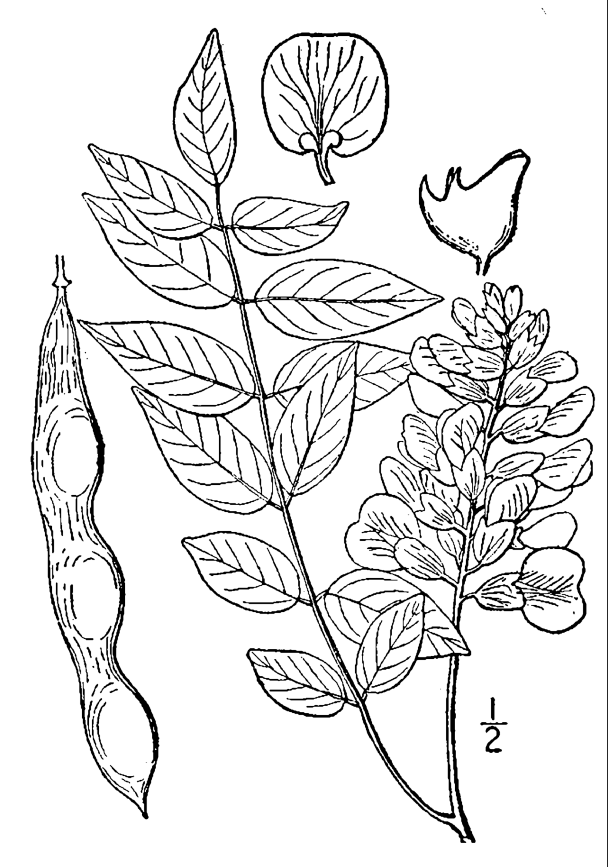 Family: Fabaceae (the pea family)
Family: Fabaceae (the pea family)
Etymology: The genus Wisteria is named for Caspar Wistar, an American physician (1), while frutescens is derived from the Latin frutico, which means “to become shrubby” (11).
Botanical synonyms: Kraunhia frutescens Small. (1), Wistaria frutescens (3), Wisteria macrostachya (Torr. & Gray) Nutt. Ex B.L. Robins. & Fern (7), Kraunhia frutescens (L.) Greene (7), Glycine frutescens L. (8).
Quick Notable Features:
¬ Leaflets with finely pubescent undersurfaces
¬ Mature bark gray with thick round lenticels
¬ Showy, fragrant purple (sometimes white) flowers abundant during the flowering period and sporadic through the rest of the growing season.
Plant Height: “High-climbing” (1)
Subspecies/varieties recognized: (none found)
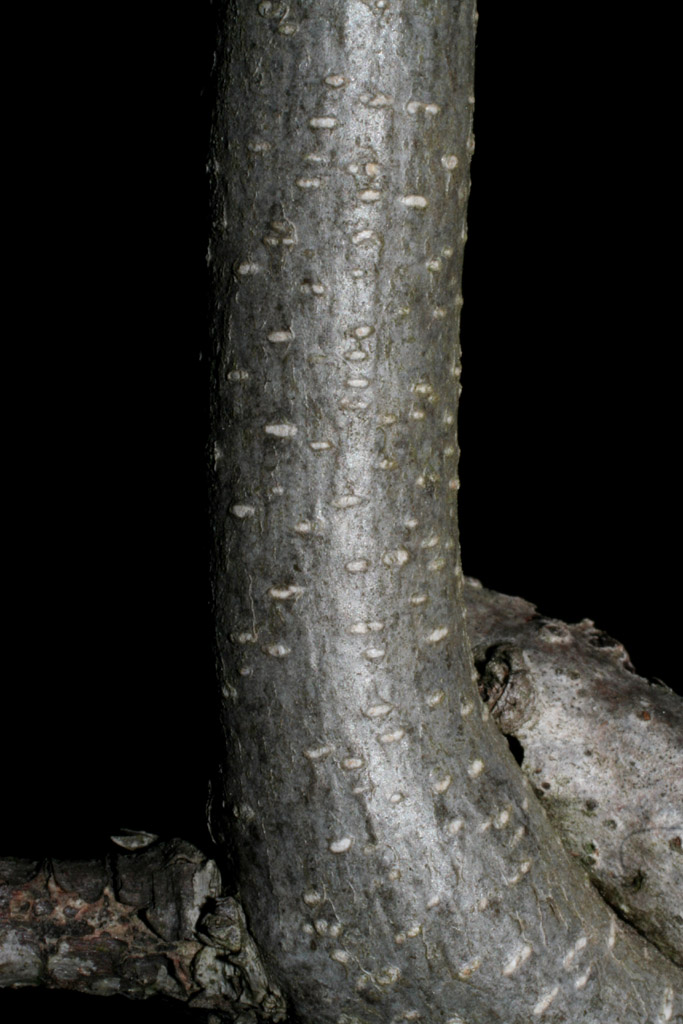 Most Likely Confused with: W. sinensis, W. floribunda, Apios americana, and possibly Campsis radicans.
Most Likely Confused with: W. sinensis, W. floribunda, Apios americana, and possibly Campsis radicans.
Habitat Preference: Moist woods, riverbanks, and alluvial forests (1).
Geographic Distribution in Michigan: Only found in Cass, Washtenaw, and Wayne Counties (7, 15), potentially introduced in one or more of those sites.
Known Elevational Distribution: (no information found)
Complete Geographic Distribution: Native to the southeastern United States, W. frutescens is now considered threatened. Growth sites have been found in most of the eastern half of the country from New York and Massachusetts south to Florida and west to Texas and Oklahoma (7).
Vegetative Plant Description: A woody perennial that is pubescent when young. When mature, the bark is gray with round lenticels. The slender stems have alternate pinnate leaves bearing minute stipules. The leaf petioles are 2-6cm long, each with a pulvinate base. Each leaf has 9-15 ovate-oblong to ovate-lanceolate leaflets, arranged oppositely along the petiole; each leaflet expands to 4-6cm long. During the early stages of leaf expansion, all parts of the leaf are “densely pubescent” (5). Later, however, the petiolules are glabrous, the leaflets are glabrous above and sparsely pubescent beneath, and their upper surfaces are darker than their undersurfaces (1, 3, 4, 5).
 Climbing Mechanism: W. frutescens climbs with the apices of its stem (1). Twining direction was noted as dextral (14) and it has been observed under cultivation twining dextrally (R. J. Burnham, pers. obs.). Undocumented sources also say it twines “clockwise”.
Climbing Mechanism: W. frutescens climbs with the apices of its stem (1). Twining direction was noted as dextral (14) and it has been observed under cultivation twining dextrally (R. J. Burnham, pers. obs.). Undocumented sources also say it twines “clockwise”.
Flower Description: The handsome racemes appear before the leaves expand. The racemes are 4-15cm long and borne on short axillary branches. The blue-purple flowers are borne on pedicels 4-10mm long; each flower is perfect, bilabiate, and 1.5-2cm long. The upper lip of the finely pubescent calyx is from a third as long up to as long as the hemispheric calyx-tube. The upper lobes of the calyx are short or connate while the lowest is elongate. The corolla is bilaterally symmetrical and clawed with obovate petals, the lower two petals forming auricles (ear-like lobes) near the base of the flower. The ten stamens are diadelphous (a group of 9 together and 1 alone) and the ovary is glabrous, stipitate, and surrounded by a glandular collar (1, 2, 4, 5). The stigma is “minutely capitate” (5).
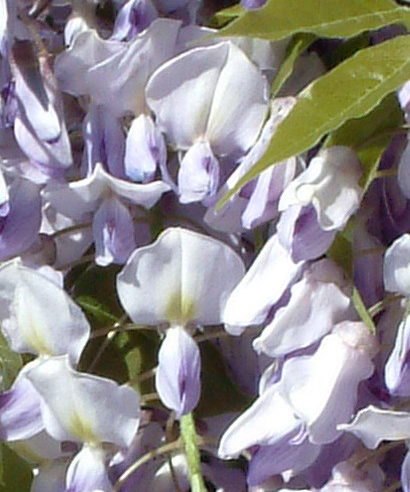 Flowering Time: Flowers from June to July in Illinois, and is noted to flower sporadically throughout the rest of summer (5, 10).
Flowering Time: Flowers from June to July in Illinois, and is noted to flower sporadically throughout the rest of summer (5, 10).
Pollinator: Carpenter bees (13).
Fruit Type and Description: A dehiscent, linear, flattened pod that is 5-10cm long, 12mm wide and glabrous. It is “many-seeded” (1).
Seed Description: Brown, 6-12mm long and somewhat reniform (5).
Dispersal Syndrome: The dehiscent pod opens late in the season, no specific dispersal agent has been found mentioned. The plant can also reproduce by adventitious roots, shoots running along the ground, or subterranean runners (5).
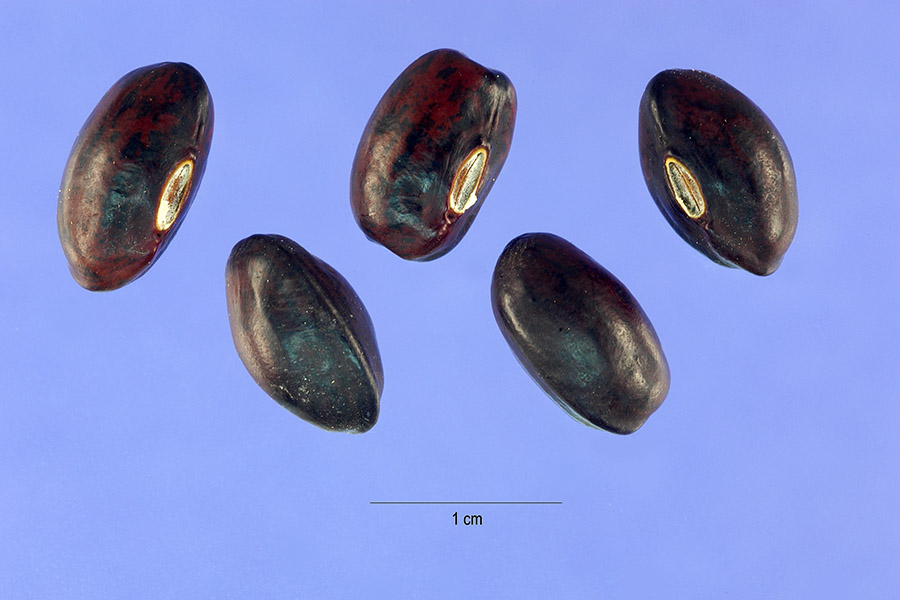 Distinguished by: According to Voss (12), the petioles and petiolules of W. sinensis are a bit longer than those of W. frutescens. Furthermore, W. frutescens has a glabrous ovary and glabrous fruits, as well as club-shaped glands on its pedicels and calyx. W. floribunda may be distinguished by its leaflets: there are more per leaf, and young leaflets are reddish. In addition, W. floribunda and W. sinensis are both much more aggressive in habit than W. frutescens.
Distinguished by: According to Voss (12), the petioles and petiolules of W. sinensis are a bit longer than those of W. frutescens. Furthermore, W. frutescens has a glabrous ovary and glabrous fruits, as well as club-shaped glands on its pedicels and calyx. W. floribunda may be distinguished by its leaflets: there are more per leaf, and young leaflets are reddish. In addition, W. floribunda and W. sinensis are both much more aggressive in habit than W. frutescens.
Vegetatively, Apios americana may be differentiated from Wisteria by its pubescent petioles and leaf veins (the leaves are pubescent on both top and bottom). Also, the completely herbaceous Apios usually has cream-colored flowers.
The leaflet margins of Campsis radicans are serrated, and the petiole is red where the petiolule intersects it. In contrast, the leaflet margins of W. frutescens are entire, and there is a yellow tint along the petiole with no spots of definite coloration. The flowers of C. radicans are pink to orange, trumpet-shaped, and born singly as opposed to the thick, purple racemes that W. frutescens bears.
Other members of the family in Michigan (number species): Wisteria (1), Amorpha (2), Amphicarpaea (1), Anthyllis (1), Apios (1), Astragalus (3), Baptisia (4), Caragana (1), Cercis (1), Chamaecrista (2), Cladrastis (1), Colutea (1), Crotalaria (1), Cytisus (1), Dalea (1), Desmodium (12), Genista (1), Gleditsia (1), Glycine (1), Gymnocladus (1), Hedysarum (1), Kummerowia (1), Lathyrus (10), Lespedeza (13), Lotus (1), Lupinus (2), Melilotus (2), Mimosa (1), Orbexilum (1), Phaseolus (2), Pisum (1), Pueraria (1), Robinia (3), Securigera (1), Senna (1), Strophostyles (1), Tephrosia (1), Trifolium (9), Vicia (8), Vigna (1) [12].
Ethnobotanical Uses: The flowers can be fried or tossed into salad (8).
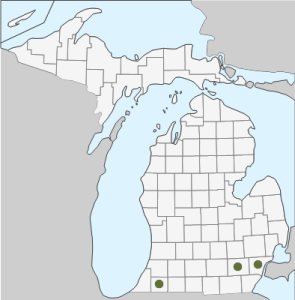 Phylogenetic Information: The Fabaceae is the primary family in the order Fabales, making up a majority of the species of the clade. Within the Fabales, Fabaceae is closely related to Polygalaceae and more distantly related to Quillajaceae and Surianaceae. The Fabales, Rosales, Cucurbitales, and Fagales are closely related within the Eurosids I, and a notable characteristic of the species within these orders is their ability to fix nitrogen. The Eurosids I are within the Eudicots clade.
Phylogenetic Information: The Fabaceae is the primary family in the order Fabales, making up a majority of the species of the clade. Within the Fabales, Fabaceae is closely related to Polygalaceae and more distantly related to Quillajaceae and Surianaceae. The Fabales, Rosales, Cucurbitales, and Fagales are closely related within the Eurosids I, and a notable characteristic of the species within these orders is their ability to fix nitrogen. The Eurosids I are within the Eudicots clade.
There is also weak support for a relation between Fabaceae and Zygophyllaceae, a family in the Zygophyllales, which is in turn within the Eurosids I (9).
Interesting Quotation or Other Interesting Factoid not inserted above:
W. frutescens will climb “into and through shrubs and small trees” (5).
Like most other members of Fabaceae, Wisteria is nitrogen-fixing (9).
Literature and websites used:
- Gleason, H.A. 1968. The New Britton and Brown Illustrated Flora of the Northeastern United States and Adjacent Canada. Hafner Publishing Co., Inc, New York.
- Gleason, H.A. and A. Cronquist. 1991. Manual of Vascular Plants of the Northeastern United States and Adjacent Canada. New York Botanical Garden: Bronx, New York.
- Parkhurst, H.E. 1903. Trees, shrubs and vines of the northeastern United States. New York, USA: C. Scribner’s Sons.
- Wood, A. 1854. Class-Book of Botany. Claremont, New Hampshire.
- Godfrey, R.K. 1988. Trees, Shrubs, and Woody Vines of Northern Florida and Adjacent Georgia and Alabama. Athens, Georgia, USA: The University of Georgia Press.
- Radford, A.E., H.E. Ahles, and C.R. Bell. 1968. Manual of the Vascular Flora of the Carolinas. Chapel Hill, NC: The University of North Carolina Press.
- USDA, NRCS. 2001. The PLANTS Database, Version 3.1, National Plant Data Center, Baton Rouge, LA 70874-4490 USA. http://plants.usda.gov/
- Plants For A Future, 1996-2003. Last modified: June 2004. http://www.pfaf.org/database/plants.php?Wisteria+frutescens
- Stevens, P.F. Angiosperm Phylogeny Website. Version 7, May 2006. http://www.mobot.org/MOBOT/research/APweb
- Illinois Plant Information Network (ILPIN) http://www.fs.fed.us/ne/delaware/ilpin/ilpin.html
- Brown, Roland Wilbur. 1954. Composition of Scientific Words. Washington, D.C.: Smithsonian Institution Press.
- Voss, E. G. 1985. Michigan Flora Part II. Ann Arbor: University of Michigan Press.
- Hill, D. B. 1998. Pollination and Honey Production in the Forest and Agroforest. Proceedings of the Center for Integrated Natural Resources and Agricultural Management 1 (4): 136-141.
- USDA’s Weed of the Week, 2004-2007. Last modified: February 2006. http://www.na.fs.fed.us/fhp/invasive_plants/weeds/exotic-wisterias.pdf
- Michigan Flora Online. A.A. Reznicek, E.G. Voss, & B.S. Walters. February 2011. University of Michigan. Web. 6-10-2014 http://michiganflora.net/home.aspx
Image Credits (all with permission):
The line drawing of the plant is from USDA-NRCS PLANTS Database / Britton, N.L., and A. Brown. 1913. An illustrated flora of the northern United States, Canada and the British Possessions. Vol. 2: 374.
The image of the stem bark is (c) 2006 Steven J. Baskauf (http://bioimages.vanderbilt.edu/).
The first image of the flowers is courtesy of Will Cook (Duke) cwcook@duke.edu
The second image of the flowers is courtesy Paul L. Redfearn, Jr., Missouri State University.
The image of the seeds is courtesy Steve Hurst @ USDA-NRCS PLANTS Database.
Species distribution map, derived from the Michigan Flora Online.
PRIMARY AUTHOR: ReBecca Sonday with final adjustments by John Bradtke and Robyn J. Burnham
© Robyn J. Burnham, University of Michigan
For additional information on Michigan Plant Diversity web pages please contact Robyn J. Burnham via email: rburnham“at”umich.edu